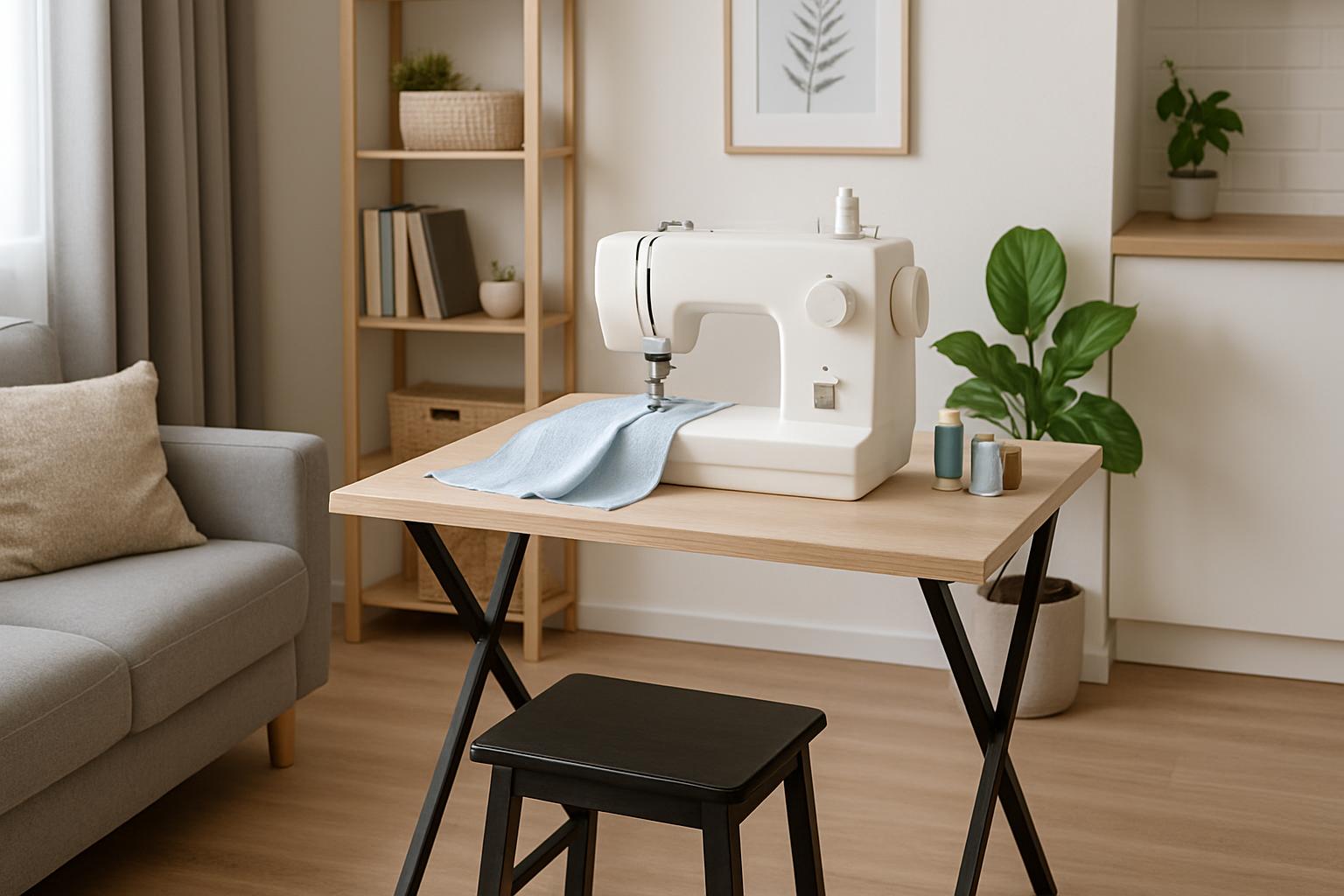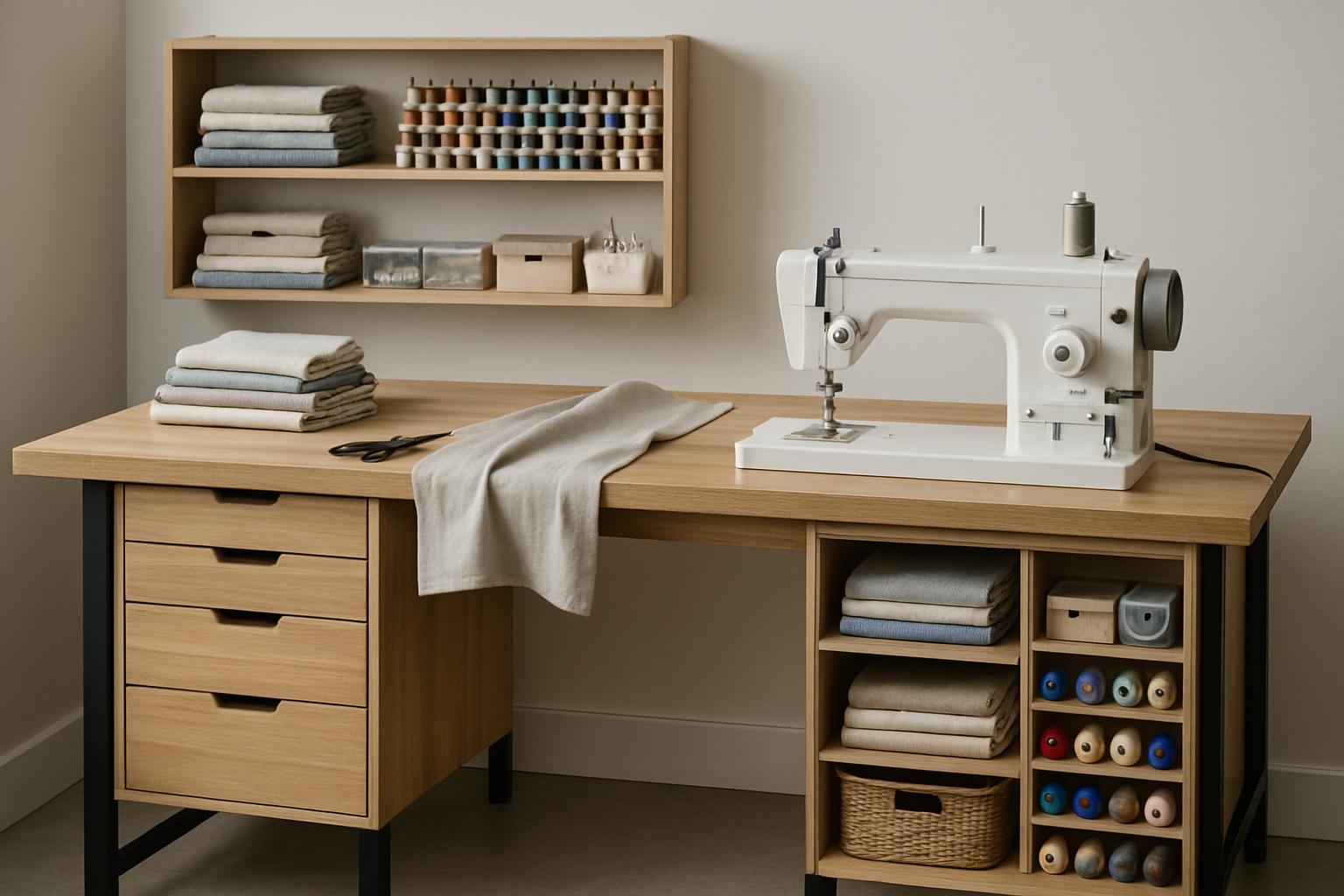For any sewing enthusiast, from beginner to seasoned professional, a dedicated sewing space is more than just a luxury—it’s a necessity. At the heart of this space lies the sewing machine table. Far from being a mere surface, the right table can transform your sewing experience, enhancing comfort, improving efficiency, and even preventing strain. This comprehensive guide will delve into the world of sewing machine tables, exploring the critical aspects of ergonomics, innovative storage solutions, and clever space-saving designs. We’ll also highlight popular types like foldable tables and cabinets, and offer practical advice for beginners looking to set up their ideal sewing station.
The Ergonomics of Sewing: Why Your Table Matters
Sewing is a rewarding hobby, but it can also be physically demanding, especially during long sessions. Poor posture can lead to back pain, neck strain, and shoulder discomfort. This is where ergonomic sewing machine tables come into play. Ergonomics in sewing furniture focuses on designing a workspace that supports your body’s natural posture, reducing fatigue and the risk of injury [1].
Key Ergonomic Considerations:
•Correct Height: The ideal sewing table height allows you to sit with your feet flat on the floor (or on a footrest) and your forearms parallel to the floor when operating the machine. Your elbows should be at or slightly above the height of the sewing machine bed [2]. Many ergonomic tables offer adjustable heights or a recessed platform that allows the sewing machine’s bed to be flush with the tabletop, creating a seamless and comfortable work surface [3].
•Chair Compatibility: An ergonomic table works best in conjunction with a good, adjustable, supportive chair. Ensure your chair allows you to maintain proper posture, with adequate lumbar support and adjustable height.
•Adequate Workspace: Beyond the machine itself, you need sufficient space for fabric, patterns, and tools. A cramped workspace forces awkward movements, increasing strain.
Investing in an ergonomically designed sewing table can significantly improve your comfort and extend your sewing sessions without discomfort.
Smart Storage Solutions: Keeping Your Space Organized
Sewing involves a myriad of tools, threads, fabrics, and notions. A cluttered workspace can hinder creativity and efficiency. Modern sewing machine tables often integrate ingenious storage solutions to keep everything organized and within reach.
Integrated Storage Features:
•Drawers and Shelves: Many sewing cabinets and tables come with multiple drawers and open shelves, perfect for organizing thread spools, bobbins, scissors, and other small notions. Some even feature specialized compartments for different types of accessories.
•Thread Spool Holders: Built-in thread racks or dedicated spool storage areas ensure your threads are neatly arranged and easily accessible.
•Lift Mechanisms: High-end sewing cabinets often include hydraulic or electric lift mechanisms that can raise and lower your sewing machine, concealing it when not in use and providing a flush work surface when sewing. This not only saves space but also protects your machine.
•Cutting Mat Storage: Some tables include dedicated slots or areas for storing large cutting mats, keeping them flat and protected.
An organized sewing space allows you to focus on your craft rather than searching for misplaced items, making your creative process smoother and more enjoyable.
Space-Saving Designs: Perfect for Small Apartments and Studios
Not everyone has a dedicated craft room. For those living in smaller apartments or multi-purpose spaces, space-saving sewing machine tables are a game-changer. These designs prioritize compactness and versatility without compromising functionality.
Popular Space-Saving Types:
•Foldable Sewing Tables: These tables are designed to fold down into a compact unit when not in use, making them easy to store against a wall or in a closet. Many feature wheels for portability, allowing you to set up your sewing station wherever and whenever you need it [4]. Some popular options include gateleg tables that can be expanded or collapsed as needed.
•Sewing Cabinets: While some cabinets are full-sized, many compact sewing cabinets offer smart, efficient storage. They often include built-in drawers, shelves, and compartments, and can conceal your sewing machine and supplies entirely when closed, blending seamlessly into your living space [5].
•Wall-Mounted or Desk Extensions: For extremely tight spaces, some creative solutions involve wall-mounted fold-down tables or desk extensions that can be pulled out only when sewing.

Popular Types of Sewing Machine Tables
Beyond their ergonomic and space-saving features, sewing machine tables come in various forms, each suited to different needs and preferences.
•Basic Flat Tables: Simple, sturdy tables that provide a flat surface for your machine. These are often the most affordable but may lack integrated storage or ergonomic features.
•Sewing Cabinets: These are furniture pieces designed specifically for sewing. They often feature a dedicated space for the machine, ample storage, and sometimes a lift mechanism. They can range from compact, discreet units to large, multi-functional workstations.
•Cutting Tables: While not strictly sewing machine tables, many sewers combine a cutting table with their sewing setup. These are typically large, sturdy, and often height-adjustable, providing ample space for cutting fabric.
•Quilting Tables: Characterized by a large, flat surface, often with an extension leaf, to support large quilting projects. Many also feature a recessed area for the sewing machine to create a flush work surface.
Practical Advice for Beginners Setting Up a Sewing Station
Setting up your first sewing station can feel overwhelming, but with a few practical tips, you can create an efficient and comfortable space, even if it’s small.
1.Choose the Right Location: Find a spot with good lighting (natural light is best) and minimal distractions. If space is limited, consider a corner or an area that can be easily tidied away.
2.Invest in a Sturdy Table: Even if it’s a basic one, ensure your table is stable and doesn’t wobble. Vibration can affect stitch quality and cause frustration. If you can, opt for a table that allows your machine to sit flush with the surface for better ergonomics.
3.Prioritize Ergonomics: Your comfort is key to enjoying sewing. Ensure your chair and table height allow for good posture. If your table isn’t adjustable, use cushions or a footrest to achieve the correct height.
4.Organize Your Tools: Start with essential tools and organize them. A small caddy, drawer organizers, or wall-mounted pegboards can keep frequently used items accessible. Label containers for easy identification.
5.Good Lighting is Essential: Supplement natural light with a task lamp that illuminates your needle area. This reduces eye strain and helps with precision.
6.Keep it Clean: Regularly clear your workspace of scraps and lint. A clean area is a productive area.
7.Personalize Your Space: Make your sewing station inspiring! Add a plant, some artwork, or photos that make you happy. A pleasant environment fosters creativity.

Conclusion: The Foundation of Your Creative Journey
A well-chosen sewing machine table is more than just furniture; it’s the foundation of a productive and enjoyable sewing experience. By prioritizing ergonomics, seeking out smart storage solutions, and considering space-saving designs, you can create a sewing station that perfectly suits your needs, no matter the size of your home or your skill level. Whether you opt for a compact foldable table or a comprehensive sewing cabinet, investing in the right setup will support your posture, organize your tools, and ultimately enhance your creative journey for years to come.
References
[1] Arrow Sewing. (2024, February 8). Setting Up An Ergonomic Sewing Space At Home, Part 1. Retrieved from https://arrowsewing.com/blog/setting-up-an-ergonomic-sewing-space-at-home-part-1/
[2] Gwenstella Made. (2024, October 15). Making the best ergonomic & adjustable sewing and cutting table. Retrieved from https://gwenstellamade.com/tutorials/making-the-best-adjustable-sewing-and-cutting-table
[3] GoldStar Tool. (2024, September 24). Choosing an Ergonomic Sewing Machine Table to Avoid Pain. Retrieved from https://www.goldstartool.com/blog/ergonomic-sewing-machine-tables-to-prevent-pain.htm
[4] Amazon. (n.d.). Foldable Sewing Table. Retrieved from https://www.amazon.com/foldable-sewing-table/s?k=foldable+sewing+table
[5] Meissner Sewing. (n.d.). Compact Sewing & Crafting Cabinets. Retrieved from https://meissnersewing.com/collections/compact-sewing-cabinets

Leave a Reply